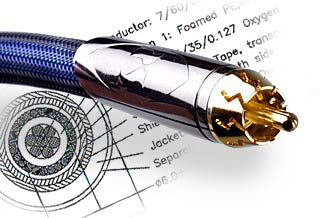You are reading the older HTML site
Positive Feedback ISSUE
12march/april 2004
ps audio
xStream interconnects
as reviewed by John Zurek

JOHN ZUREK'S SYSTEM LOUDSPEAKERS
ELECTRONICS SOURCES CABLES ACCESSORIES
|
This is the second of three reviews on PS Audio's xStream cable products, this time on Paul McGowan's top-shelf Statement model interconnects. I was planning to have this review ready in time for the New Year, but it was not to be. My PS Audio HCA-2 amplifier went out, at just the wrong time—the Friday before Christmas week. I called PS Audio to see if I could get a loaner, but they are a sane company, and suggested we take care of this after the holidays and perhaps after CES. Arghh! No music, except for my headphone rig. I had to wait ‘til the PS Audio folks got back from Vegas to send the amplifier in for a quick once over. Once they got it though, let’s say that they are serious about customer support! My amp was back to me within a couple of days.
Wire Lust
Why the hell are most audiophiles so crazed about cables? I remember putting together my first "real" system. A friend in the know said I might have to spend up to four C-notes (whaaattt!) for cables. I was in interconnect shock. $400?? I could barely come up with the dinero for the speakers and amp! For the kind of money those components cost, they should throw in solid gold wires! This was before I had heard of Nordost, Tara, Audioquest, Transparent, Kimber, etc. I didn't have the scratch, so I bought Straightwire entry-level interconnects for $25 and was happy. They looked cooler (and were way more expensive) than anything I’d had before, so they had to be good.
Then I learned about better budget cables, and got some of those PBJs. I could afford $60. As my disease progressed, I learned about really cool, expensive cables, and made a vow. Someday, I too would own Cardas, or MIT, or whatever cable was reviewed that month. Did it matter that I hadn't heard it? Nah. Would it work with my gear? Who cares? It looked cool. The more expensive the better, right? Admit it. You went through that phase. You may still be in it. Cable Lust.
Then something happened—I learned to trust my ears. I heard good and great cables that were not so expensive, and not-so-good cables that were very expensive. My conclusion: Is there one best wire out there? I don't think so. There is only the wire that works best: (1) between the components it is connected to, (2) in the room you are in, and (3) for the type of sound that you prefer. Lots of variables in that equation! You can't even use Kirchoff's law to solve it. No wonder there are so many cables and so many opinions. If it doesn't work for you, it doesn't work. End of story.
Heavy Metal
I wasn't quite sure what to expect from the Statements. The PS folks make some very bold claims about them on their website, plus I'd heard a lot of very positive buzz on the audio-geek websites. They are beautiful, and heavy! The connectors are unlike any I've seen. Each is hand polished and has thick, 24-carat gold plating over nickel—it’s like touching jewelry. The jacket is a striking royal-blue color with awesome textured webbing. My wife, collector of gold, silver, and diamonds (most of us married audio geeks know that buying jewelry enhances our chance of getting new components) said they were drop-dead gorgeous. Audio bling-bling? Absolutely!

From the PS Audio website: "The outermost shield is a 90% OFC copper braid woven just under the outer jacket material. This braid helps reduce the lower frequency noise from outside interference sources. The second level of shielding comes from a double wrap of aluminum foil just under the OFC braid. This foil is especially useful in eliminating higher frequency interference such as cell phones, wireless phones, along with digital and video inferences." The back of the connector is cut diagonally, so there is no heat shrink where the cable meets the connector. The outside of the RCA plug has a Z-shaped gap that expands when you fit it over the female connector. It seats firmly, though it’s not the tightest I've ever encountered.
The Statements are completely separate cables. Right channel and signal direction is indicated only by red lettering. Look closely! I didn't think they were directional at first, but it does matter which end you hook up where. The conductors are copper, and lots of it! It’s not just the usual type of high-grade copper, but a "correct blend of gauge and amount." The formula was discovered by PS Audio when they were designing the Lab power cable, the Statement power cable’s first-generation cousin.
The Sound
 I
started out with "This Weight," from Van Morrison’s The Healing Game.
The presentation immediately had more, well, weight. All of the low
frequencies were more detailed and had greater impact. The bass drum had
more punch, and more wood. It wasn’t just beater striking head, like so many
over-damped bass drums in recordings these days. The sustained notes on the
string bass were much longer—a good sign. It was not like the
presentation you get when you turn up a bass tone control. That usually
makes things thick, lumpy, and ill defined. With the Statements, the bass
was anything but ill defined. The percussion on the Hammond organ was more
prominent and biting, like a live Hammond with a Leslie. The mids and highs
were very precise, and the overall presentation was nice and quick. I could
not detect any obvious colorations. It seemed like someone added more
overtones in the lower regions, and left everything else alone. I heard all
sorts of low-level information in the mid and low bass I had never heard,
somehow without affecting the mids and highs. Awesome. I really felt I was
missing something when I listened again without the Statements.
I
started out with "This Weight," from Van Morrison’s The Healing Game.
The presentation immediately had more, well, weight. All of the low
frequencies were more detailed and had greater impact. The bass drum had
more punch, and more wood. It wasn’t just beater striking head, like so many
over-damped bass drums in recordings these days. The sustained notes on the
string bass were much longer—a good sign. It was not like the
presentation you get when you turn up a bass tone control. That usually
makes things thick, lumpy, and ill defined. With the Statements, the bass
was anything but ill defined. The percussion on the Hammond organ was more
prominent and biting, like a live Hammond with a Leslie. The mids and highs
were very precise, and the overall presentation was nice and quick. I could
not detect any obvious colorations. It seemed like someone added more
overtones in the lower regions, and left everything else alone. I heard all
sorts of low-level information in the mid and low bass I had never heard,
somehow without affecting the mids and highs. Awesome. I really felt I was
missing something when I listened again without the Statements.
On to some Beethoven—the Quartet in E flat, Opus 127, performed by the Tokyo String Quartet. This is a fabulous recording, and in my opinion, one of the best cycles of Beethoven’s work for four string players out there. The late quartets are difficult to perform, and gifted musicians are required to make them work. They are hard to interpret, and sometimes hard to listen to. The first movement of Opus 127, "Maestoso," is very busy, and relies on rhythmic litheness to propel it. Without that, it will wither and die. With the Statements, it was killer. The wood in the instruments came alive, and the cables added the type of punch I usually associate with drums. I wasn’t quite dancing, but it really made me move.
Until this point, I used just one pair of Statements, a five-meter run between my amp and preamp. So far, they did exactly what PS Audio claimed—they gave me a more robust lower end without distorting the rest of the presentation. Would two Statements be too much? I connected another pair between my CD player and preamp. My impression? Most of the time, two Statements were awesome. In fact, with acoustic and orchestral music, that was the configuration I preferred. When I experimented with electric music, it depended upon the recording. Sometimes I liked the combination of one pair of Statements with a not-to-be-named pure silver interconnect. Only once—on a MoFi recording of Bob Marley’s Exodus—did the combination of two Statements go overboard, but this is the most bass-heavy recording I own.
Conclusion
So what to make of the Statements? If you want strict neutrality, go to Switzerland. You ain’t gettin’ it here. Then again, I’m wondering whether all the cables that are so "neutral" aren’t missing the low-frequency info that the Statements provide. If you want exactly what PS Audio advertises—big, robust, sound, full of mid-bass energy and low-end power, yet uncolored—I recommend trying at least one pair in your playback chain. I loved them. John Zurek
xStream interconnects
Retail: $299.95
PS Audio
web address: www.psaudio.com
